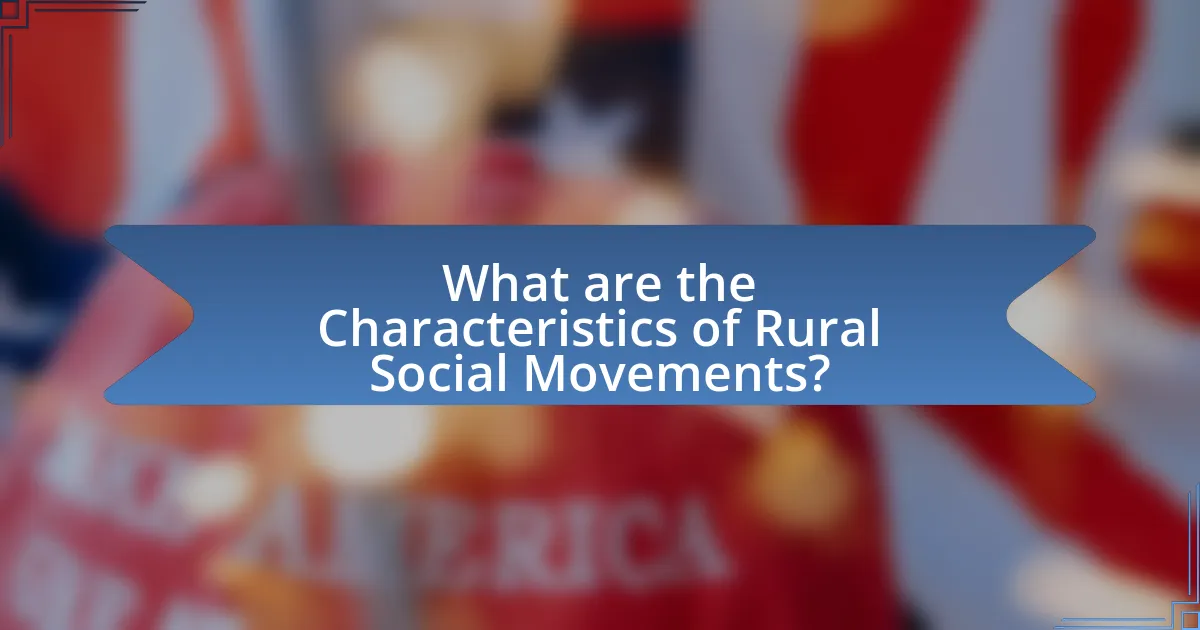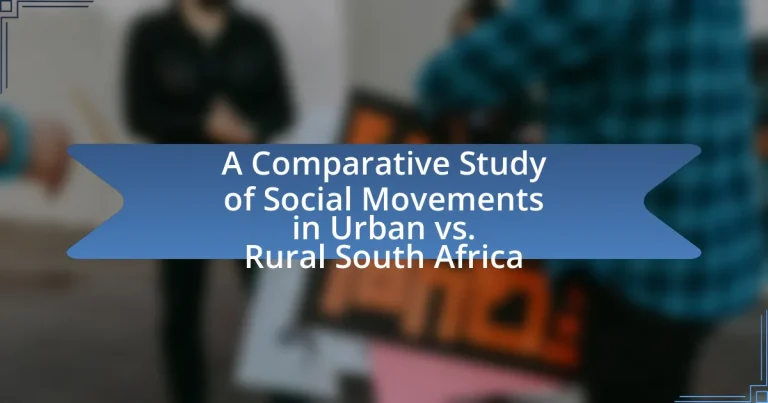The article provides a comparative analysis of social movements in urban and rural South Africa, highlighting their characteristics, formation factors, and the challenges they face. It examines how urban movements typically focus on labor rights and housing issues, while rural movements prioritize land rights and agricultural policies. The article also discusses the impact of socioeconomic conditions, political opportunities, and community structures on the effectiveness of these movements. Additionally, it emphasizes the importance of understanding these differences to enhance strategies for social change and advocacy in both contexts.

What are Social Movements in South Africa?
Social movements in South Africa are organized efforts by groups of people to promote or resist social change, often focusing on issues such as inequality, human rights, and environmental justice. These movements have played a significant role in the country’s history, particularly during the anti-apartheid struggle, where organizations like the African National Congress mobilized mass support against racial oppression. Contemporary social movements, such as the Fees Must Fall campaign, address issues like education access and economic inequality, reflecting ongoing societal challenges. The effectiveness and strategies of these movements can vary significantly between urban and rural contexts, influenced by factors such as population density, access to resources, and local governance structures.
How do social movements differ in urban and rural contexts?
Social movements in urban contexts typically focus on issues like labor rights, housing, and social justice, while rural movements often emphasize land rights, agricultural policies, and local governance. Urban movements benefit from higher population density, which facilitates mobilization and access to resources, whereas rural movements may face challenges such as geographic isolation and limited communication infrastructure. For instance, the urban anti-apartheid movement in South Africa gained momentum through organized protests and strikes, while rural movements, such as those advocating for land reform, often rely on community gatherings and local networks to mobilize support. These differences highlight how the socio-economic environment shapes the strategies and goals of social movements in varying contexts.
What factors influence the formation of social movements in urban areas?
The formation of social movements in urban areas is influenced by factors such as socioeconomic inequality, political repression, and demographic diversity. Socioeconomic inequality creates grievances among marginalized groups, prompting collective action to address disparities, as evidenced by the rise of movements like the Fees Must Fall campaign in South Africa, which emerged in response to rising tuition costs and economic barriers. Political repression can also catalyze social movements, as seen in urban areas where government actions limit freedoms, leading to organized resistance. Additionally, demographic diversity in urban settings fosters a mix of perspectives and experiences, which can unite various groups around common causes, enhancing the potential for mobilization.
What factors influence the formation of social movements in rural areas?
The formation of social movements in rural areas is influenced by factors such as economic conditions, social networks, political opportunities, and cultural contexts. Economic conditions, including poverty and unemployment, often drive individuals to mobilize for change, as seen in rural South Africa where economic disparities have led to protests for land rights and better services. Social networks play a crucial role, as communities with strong ties are more likely to organize collectively; for instance, rural communities often rely on kinship and local organizations to facilitate mobilization. Political opportunities, such as the presence of sympathetic political allies or favorable legal frameworks, can also encourage the emergence of social movements; in South Africa, the post-apartheid era provided new avenues for rural activism. Lastly, cultural contexts, including shared identities and historical grievances, shape the motivations and strategies of rural social movements, as evidenced by the ongoing struggles for recognition and rights among marginalized groups in these areas.
Why are social movements important in South Africa?
Social movements are important in South Africa because they serve as a catalyst for social change and political reform. These movements have historically addressed issues such as racial inequality, economic injustice, and human rights violations, significantly influencing national policies and societal norms. For instance, the anti-apartheid movement mobilized millions and ultimately led to the dismantling of apartheid laws in the early 1990s, showcasing the power of collective action. Additionally, contemporary movements, such as the Fees Must Fall campaign, highlight ongoing struggles for access to education and economic opportunities, reflecting the persistent inequalities in South African society. Thus, social movements are crucial for advocating marginalized voices and driving systemic change in both urban and rural contexts.
How do social movements contribute to social change?
Social movements contribute to social change by mobilizing collective action to challenge existing power structures and advocate for policy reforms. For instance, in South Africa, movements such as the Anti-Apartheid Movement successfully united diverse groups to dismantle institutionalized racial segregation, leading to significant political and social transformations. Additionally, contemporary movements addressing issues like land reform and service delivery in both urban and rural areas continue to influence government policies and public awareness, demonstrating the ongoing impact of organized collective efforts on societal norms and legislation.
What role do social movements play in political engagement?
Social movements play a crucial role in political engagement by mobilizing individuals to advocate for social change and influence policy decisions. They serve as platforms for collective action, enabling marginalized groups to voice their concerns and demand rights, thereby fostering greater political participation. For instance, the anti-apartheid movement in South Africa galvanized widespread public support and led to significant political reforms, demonstrating how social movements can reshape political landscapes. Additionally, research indicates that social movements enhance civic awareness and encourage grassroots organizing, which are essential for a vibrant democracy.

What are the Characteristics of Urban Social Movements?
Urban social movements are characterized by their focus on local issues, collective action, and the mobilization of diverse groups. These movements often address urban-specific challenges such as housing, transportation, and environmental justice, reflecting the unique socio-economic conditions of urban areas. For instance, the 2012 Marikana miners’ strike in South Africa exemplifies how urban social movements can arise from labor disputes and demand systemic change. Additionally, urban social movements typically utilize digital platforms for organization and outreach, enhancing their ability to connect with a broader audience and mobilize support quickly. This reliance on technology is evident in movements like #FeesMustFall, which gained traction through social media to advocate for affordable education.
How do urban social movements mobilize support?
Urban social movements mobilize support through grassroots organizing, strategic communication, and coalition-building. These movements often engage local communities by addressing specific issues such as housing, labor rights, or environmental justice, which resonate with residents’ immediate concerns. For instance, the Abahlali baseMjondolo movement in South Africa effectively mobilized support by advocating for the rights of shack dwellers, utilizing social media to spread awareness and organize protests, thereby increasing visibility and participation. Additionally, urban social movements frequently collaborate with NGOs and other civic organizations to amplify their reach and resources, enhancing their ability to mobilize diverse groups of supporters.
What strategies do urban movements use to gain visibility?
Urban movements use strategies such as social media campaigns, public demonstrations, and community engagement to gain visibility. Social media platforms allow movements to reach a wider audience quickly, facilitating the dissemination of information and mobilization of supporters. Public demonstrations, including protests and rallies, attract media attention and raise awareness about specific issues, as evidenced by the global visibility achieved during movements like Black Lives Matter. Community engagement initiatives, such as workshops and local meetings, foster grassroots support and encourage participation, thereby amplifying the movement’s message within urban settings. These strategies collectively enhance the visibility and impact of urban movements.
How do urban social movements utilize technology and social media?
Urban social movements utilize technology and social media to organize, mobilize, and amplify their messages effectively. These platforms enable activists to communicate rapidly, share information, and coordinate actions, often leading to increased participation and visibility. For instance, during the #FeesMustFall movement in South Africa, social media was instrumental in mobilizing thousands of students across various universities, demonstrating the power of digital communication in fostering solidarity and collective action. Additionally, technology facilitates the dissemination of real-time updates and the documentation of events, which can attract media attention and public support, further validating the role of social media in enhancing the impact of urban social movements.
What challenges do urban social movements face?
Urban social movements face significant challenges, including state repression, resource limitations, and internal divisions. State repression manifests through police violence, legal restrictions, and surveillance, which can stifle activism and intimidate participants. Resource limitations often hinder these movements’ ability to mobilize effectively, as they may lack funding, organizational infrastructure, and access to media platforms. Internal divisions, such as differing ideologies and goals among participants, can lead to fragmentation and weaken collective action. These challenges are evident in various urban contexts, where movements struggle to maintain momentum and achieve their objectives amidst external pressures and internal conflicts.
How do government policies impact urban social movements?
Government policies significantly influence urban social movements by shaping the political, economic, and social environment in which these movements operate. For instance, policies that promote social justice and equitable resource distribution can empower urban social movements, as seen in South Africa’s post-apartheid era, where the government implemented policies aimed at addressing historical inequalities. Conversely, repressive policies, such as restrictions on assembly and freedom of speech, can stifle these movements, leading to increased tensions and protests, as evidenced by the 2012 Marikana miners’ strike, which was met with heavy police action. Thus, the nature of government policies directly affects the effectiveness and trajectory of urban social movements.
What are the effects of urbanization on social movements?
Urbanization significantly influences social movements by facilitating greater organization and mobilization among diverse populations. In urban areas, the concentration of people leads to increased interaction and the sharing of ideas, which can catalyze collective action. For instance, the rise of informal settlements in South Africa has prompted movements advocating for housing rights, as seen in the Abahlali baseMjondolo movement, which emerged in response to urban poverty and inadequate living conditions. Furthermore, urbanization often provides access to resources such as media and technology, enhancing the visibility and impact of social movements. Research indicates that urban social movements are more likely to gain national attention and support due to their proximity to political and economic centers, as evidenced by the 2012 Marikana miners’ strike, which highlighted labor rights issues on a global scale.

What are the Characteristics of Rural Social Movements?
Rural social movements are characterized by their focus on local issues, community solidarity, and grassroots organization. These movements often arise in response to specific challenges faced by rural populations, such as land rights, agricultural policies, and access to resources. For instance, the Landless People’s Movement in South Africa exemplifies how rural social movements mobilize communities to advocate for land reform and social justice. Additionally, rural social movements typically emphasize cultural identity and traditional practices, which serve to strengthen community ties and collective action. The reliance on local leadership and informal networks further distinguishes these movements from urban counterparts, as they often operate outside formal political structures.
How do rural social movements organize their efforts?
Rural social movements organize their efforts through grassroots mobilization, community engagement, and coalition-building. These movements often rely on local leaders and networks to facilitate communication and coordination among members, ensuring that the voices of rural populations are represented. For instance, in South Africa, organizations like the Rural Women’s Assembly have successfully united various groups to advocate for land rights and social justice, demonstrating the effectiveness of collective action in rural contexts. This approach is supported by evidence showing that rural movements often leverage traditional structures and local knowledge to enhance their organizational capacity and influence policy changes.
What community structures support rural social movements?
Community structures that support rural social movements include local organizations, cooperatives, and grassroots networks. These structures facilitate collective action by providing resources, fostering communication, and enhancing solidarity among community members. For instance, local organizations often mobilize residents around shared interests, while cooperatives can offer economic support and shared services, which are crucial for sustaining movements. Grassroots networks enable the dissemination of information and strategies, empowering individuals to engage in advocacy and activism. Research indicates that such community structures are vital for the success of rural social movements, as they enhance participation and amplify voices in the political arena.
How do rural movements address local issues?
Rural movements address local issues by organizing communities to advocate for their rights and needs, focusing on land reform, access to resources, and social justice. These movements mobilize local populations to raise awareness about specific challenges, such as inadequate infrastructure and agricultural support, often leading to policy changes. For instance, the Landless People’s Movement in South Africa has successfully highlighted land redistribution issues, influencing government policies aimed at addressing historical injustices. Additionally, rural movements often collaborate with NGOs and governmental bodies to implement sustainable development initiatives, thereby directly impacting local livelihoods and community resilience.
What challenges do rural social movements encounter?
Rural social movements encounter significant challenges, including limited access to resources, political marginalization, and inadequate infrastructure. These movements often struggle to secure funding and support, which hampers their ability to mobilize effectively. Additionally, rural communities frequently face political exclusion, making it difficult for their voices to be heard in decision-making processes. For instance, a study by the Human Sciences Research Council highlights that rural areas in South Africa often lack representation in local governance, leading to a disconnect between community needs and policy responses. Furthermore, poor infrastructure, such as inadequate transportation and communication networks, complicates organization and outreach efforts, ultimately undermining the effectiveness of rural social movements.
How does isolation affect rural social movements?
Isolation significantly hinders rural social movements by limiting access to resources, information, and networks necessary for mobilization. In rural areas, geographical remoteness often results in reduced communication and collaboration opportunities, which are vital for organizing collective actions. For instance, studies have shown that rural communities in South Africa face challenges such as inadequate infrastructure and limited internet connectivity, which restrict their ability to engage with broader social movements and share their grievances effectively. This isolation can lead to a lack of awareness about social issues and diminish the potential for solidarity among rural activists, ultimately weakening their impact compared to urban counterparts who benefit from more robust networks and resources.
What role does access to resources play in rural movements?
Access to resources is crucial for rural movements as it directly influences their capacity to mobilize, organize, and advocate for change. In rural areas, limited access to financial, educational, and infrastructural resources often hinders the effectiveness of social movements. For instance, a study by the South African Human Sciences Research Council found that rural communities with better access to resources, such as education and healthcare, are more likely to engage in collective action and successfully address local issues. This correlation highlights that resource availability not only empowers rural populations but also enhances their ability to negotiate with authorities and implement sustainable development initiatives.
How can understanding these differences enhance social movement strategies?
Understanding the differences between urban and rural social movements in South Africa can enhance social movement strategies by allowing activists to tailor their approaches to the specific needs and contexts of each environment. For instance, urban movements often focus on issues like housing and employment, while rural movements may prioritize land rights and agricultural support. By recognizing these distinct priorities, strategists can develop targeted messaging and mobilization tactics that resonate more effectively with their respective audiences. Research indicates that movements that align their strategies with local contexts are more likely to achieve their goals; for example, the Landless People’s Movement in rural areas has successfully advocated for land reform by addressing local agricultural concerns, demonstrating the effectiveness of context-specific strategies.
What best practices can be adopted from both urban and rural movements?
Best practices that can be adopted from both urban and rural movements include community engagement, grassroots organizing, and adaptive strategies. Community engagement fosters local participation, ensuring that the voices of residents are heard and considered in decision-making processes. Grassroots organizing empowers individuals to mobilize around shared interests, creating a strong network of support and advocacy. Adaptive strategies allow movements to respond effectively to changing circumstances, drawing on the flexibility seen in rural movements and the resourcefulness of urban initiatives. These practices have been shown to enhance the effectiveness of social movements, as evidenced by successful campaigns in both settings that have led to tangible policy changes and community improvements.


